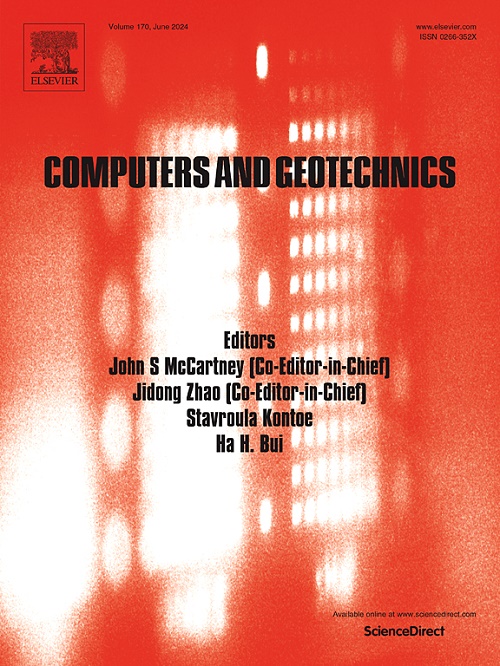软土地基中群桩负摩阻力的数值计算
IF 6.2
1区 工程技术
Q1 COMPUTER SCIENCE, INTERDISCIPLINARY APPLICATIONS
引用次数: 0
摘要
负摩阻(NSF)的调动通过降低桩的轴向承载能力和引起附加沉降而对桩施加有害荷载,即阻力荷载。采用牺牲桩群布置可以减小这一阻力。然而,对于桩群中非源动力的动员,特别是在软土蠕变的背景下,了解仍然有限。本文采用剪切平面算法将弹粘塑性模型成功地实现到有限元包中。通过离心试验验证了数值研究,研究了在不同桩距下牺牲桩对中心桩减阻的影响(称为群效应)。对桩距、端承土刚度和蠕变系数等不同变量下的群效应进行了参数化研究。结果表明,在牺牲桩间距7d以上,d为牺牲桩直径,群效应可以忽略不计。此外,群体效应高度依赖于特定地点的蠕变行为,在高蠕变条件下变得不那么显著。群桩效应的主要原因是群桩内土体有效应力的减小。本文章由计算机程序翻译,如有差异,请以英文原文为准。
Numerical assessment of negative skin friction on pile groups in soft ground
The mobilization of negative skin friction (NSF) imposes a detrimental load, known as dragload, on piles by reducing their axial bearing capacity and inducing additional settlement. The adoption of sacrificial piles arranged in a group configuration can reduce this dragload. However, the understanding of NSF mobilization in pile groups, particularly in the context of soft soil creep, remains limited. This paper successfully implements an elastic viscoplastic model with a cutting plane algorithm into a finite element package. Numerical investigations, validated through centrifuge tests, are conducted to examine the effect of sacrificial piles on the dragload reduction in the center pile (termed as group effect) at varying pile spacings. A parametric investigation is conducted to quantify the group effect under different variables, including pile spacing, end-bearing soil stiffness and creep coefficient. Results reveal that beyond the spacing of 7 d, where d is the diameter of sacrificial piles, the group effect can be neglected. Furthermore, the group effect is highly dependent on the site-specific creep behavior, becoming less significant under high creep conditions. The reduction in effective stress of soil within a pile group is identified as the primary cause of the NSF pile group effect.
求助全文
通过发布文献求助,成功后即可免费获取论文全文。
去求助
来源期刊

Computers and Geotechnics
地学-地球科学综合
CiteScore
9.10
自引率
15.10%
发文量
438
审稿时长
45 days
期刊介绍:
The use of computers is firmly established in geotechnical engineering and continues to grow rapidly in both engineering practice and academe. The development of advanced numerical techniques and constitutive modeling, in conjunction with rapid developments in computer hardware, enables problems to be tackled that were unthinkable even a few years ago. Computers and Geotechnics provides an up-to-date reference for engineers and researchers engaged in computer aided analysis and research in geotechnical engineering. The journal is intended for an expeditious dissemination of advanced computer applications across a broad range of geotechnical topics. Contributions on advances in numerical algorithms, computer implementation of new constitutive models and probabilistic methods are especially encouraged.
 求助内容:
求助内容: 应助结果提醒方式:
应助结果提醒方式:


